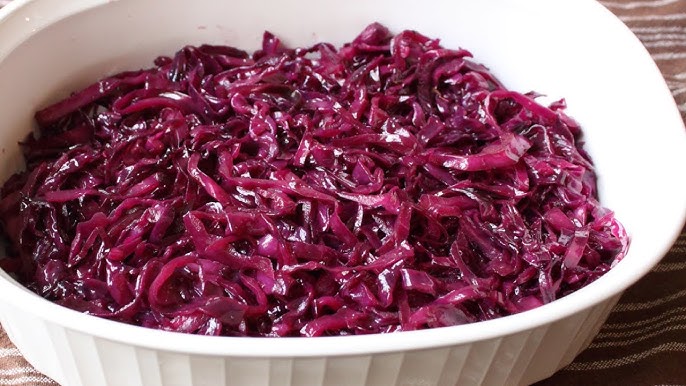Braised Cabbage Recipe: Braised cabbage is one of those dishes that often surprises people. At first glance, cabbage doesn’t always get the recognition it deserves—it’s seen as a simple, inexpensive vegetable. But when prepared the right way, especially through braising, cabbage transforms into a tender, flavorful side dish that’s rich, savory, and comforting. This dish is commonly enjoyed across different cuisines, from Eastern European kitchens to Southern-style American meals. It brings together a combination of sweet, tangy, and earthy flavors that make it incredibly versatile.
So, what makes braising cabbage so special? Unlike steaming or boiling, braising involves cooking the cabbage slowly in a mixture of broth, vinegar, or wine with spices and aromatics. This method allows the flavors to penetrate deep into the leaves, giving you a melt-in-your-mouth texture. Plus, braised cabbage pairs beautifully with meats like pork, beef, or chicken, making it a perfect side dish for family dinners, festive gatherings, or even as a comforting weeknight meal.
Many people also love braised cabbage because it’s budget-friendly. With just a few basic ingredients, you can whip up a dish that feels hearty and gourmet without breaking the bank. It’s also very forgiving—once you master the basics, you can play around with different seasonings and ingredients to make it your own.
Why Braised Cabbage is a Must-Try Dish
If you’re wondering whether braised cabbage is worth making, let’s break down a few reasons why it should be on your recipe list. First, it’s incredibly nutritious. Cabbage is packed with vitamins C and K, along with fiber that helps with digestion. When braised, it retains much of its nutritional value while becoming tender and easy to eat.
Second, it’s flavorful yet simple. The slow-cooking process allows the cabbage to absorb the richness of the broth, butter, and seasonings. Depending on your taste preference, you can make it slightly sweet, tangy, or even spicy.
Third, braised cabbage is versatile. Whether you’re serving roasted pork chops, baked chicken, or a vegetarian main dish, braised cabbage works as a delicious side that balances heavier meals with its light, tender texture.
Lastly, it’s comfort food at its best. The warm, savory flavors make it a cozy addition to cold-weather meals, yet it’s also light enough to serve year-round.
Origins and Cultural Significance of Braised Cabbage
Braised cabbage isn’t tied to just one culture—it has variations across many countries. In Germany and Eastern Europe, red cabbage is often braised with apples and vinegar, creating a sweet-and-sour flavor that pairs beautifully with roasted meats and sausages. In Southern American cuisine, braised cabbage often includes bacon, onions, and a splash of vinegar, making it rich, smoky, and tangy.
In Asian cuisine, you’ll often find cabbage braised with soy sauce, ginger, and garlic, bringing out umami-rich flavors. Meanwhile, in Irish cooking, braised cabbage is a traditional part of hearty meals, often served alongside corned beef or roasted meats.
The beauty of braised cabbage is that it’s a humble dish that adapts well to whatever ingredients and seasonings are available. Over the years, it has evolved into countless versions, each carrying cultural flavors and family traditions.
Ingredients You’ll Need
One of the best things about braised cabbage is how simple and affordable the ingredient list is. You don’t need anything fancy—just a few staples you probably already have in your kitchen.
Main Ingredients for Braised Cabbage
- 1 medium green or red cabbage (about 2–3 lbs), cored and sliced
- 2–3 tablespoons olive oil or butter
- 1 large onion, thinly sliced
- 2–3 garlic cloves, minced
- 1 cup vegetable broth (or chicken/beef broth for added flavor)
- 2 tablespoons apple cider vinegar (or red wine vinegar)
- Salt and black pepper, to taste
Optional Add-Ins for Extra Flavor
- 1–2 apples, peeled and sliced (for sweetness)
- ½ teaspoon caraway seeds or fennel seeds
- 1 tablespoon brown sugar or honey
- 1–2 strips of bacon or pancetta (for smokiness)
- Red pepper flakes (for heat)
Ingredient Substitutions and Variations
- Use red cabbage for a more colorful dish.
- Swap olive oil with butter for a richer taste.
- Replace apple cider vinegar with lemon juice or white wine.
- For a vegetarian version, stick with vegetable broth, while for meat lovers, chicken or beef broth enhances depth.
Kitchen Tools and Equipment
Before you start cooking, it helps to gather the right tools. While braising cabbage doesn’t require anything complicated, the right cookware can make a huge difference in achieving that soft, flavorful result.
Essential Cookware for Braising
- Large Dutch oven or heavy-bottomed pot – retains heat well and cooks evenly.
- Sharp chef’s knife – for slicing cabbage into thin strips.
- Cutting board – a sturdy surface for prepping.
- Wooden spoon or spatula – for stirring without damaging your pot.
Helpful Accessories to Make Cooking Easier
- Measuring cups and spoons – for precise seasoning.
- Tongs – helpful for stirring large amounts of cabbage.
- Lid for your pot – essential for trapping steam and allowing the cabbage to soften while braising.
Having everything ready before you begin ensures that the cooking process flows smoothly, especially since braising is all about slow, steady cooking.
Step-by-Step Guide to Making Braised Cabbage
Now that you have your ingredients and tools ready, let’s dive into the actual cooking process. Braising cabbage is straightforward, but each step builds flavor and ensures a perfect final dish.
Step 1 – Prepping the Cabbage
The first step is to clean and slice your cabbage. Remove any wilted or tough outer leaves, then cut the cabbage in half and remove the core. From there, slice it into thin ribbons. This ensures even cooking and allows the flavors to seep into each layer.
Washing your cabbage thoroughly is important because sometimes dirt or small insects can be hidden between the leaves. Once washed, pat it dry with a towel before slicing.
At this stage, you can also prep your other ingredients—slice the onions, mince the garlic, and measure out the broth and vinegar. Getting everything ready before cooking makes the process smooth and enjoyable.
Step 2 – Sautéing Aromatics
Once your cabbage is prepped and ready, the next step is building the flavor base. Heat olive oil or butter in your Dutch oven or heavy-bottomed pot over medium heat. Add sliced onions first and let them cook until they turn translucent and slightly golden. This caramelization process adds a natural sweetness that balances the earthiness of the cabbage.
Next, toss in the minced garlic. Be careful not to burn it—garlic cooks quickly, so a quick stir for about 30 seconds to a minute is enough. If you’re using bacon or pancetta for extra richness, now’s the time to add it. Let it render and crisp up slightly before adding the vegetables.
Sautéing aromatics may seem like a small step, but it’s what transforms braised cabbage from plain to flavorful. The onions, garlic, and fats create a base that the cabbage will absorb as it cooks. Think of this stage as laying the foundation of your dish—it determines how deep and savory the final taste will be.
Step 3 – Adding Liquids and Seasonings
Now comes the heart of braising—adding liquid and spices to cook the cabbage slowly. Once your aromatics are fragrant, add the sliced cabbage to the pot. It may look like too much at first, but don’t worry—cabbage wilts down significantly as it cooks.
Pour in the broth of your choice (vegetable, chicken, or beef) and the apple cider vinegar. The broth provides richness, while the vinegar adds brightness and helps cut through the cabbage’s natural bitterness. If you prefer a sweeter version, this is also when you can sprinkle in brown sugar or add sliced apples.
Season with salt and freshly cracked black pepper. For a more complex flavor, toss in caraway seeds, fennel seeds, or even a pinch of smoked paprika. Stir everything well, making sure the cabbage is coated evenly in the liquid and seasonings.
This stage sets up the braising process. The combination of broth and vinegar will create steam when covered, softening the cabbage while infusing it with flavor.
Step 4 – Simmering to Perfection
Cover the pot with a lid, reduce the heat to low, and let the cabbage simmer gently. This slow cooking process usually takes about 30–40 minutes, depending on how tender you like your cabbage. Stir occasionally to make sure everything cooks evenly and doesn’t stick to the bottom.
As the cabbage cooks, it becomes silky and absorbs all the savory, tangy, and slightly sweet notes from the broth and seasonings. The liquid should reduce slightly, forming a flavorful sauce that clings to the cabbage. If the pot ever looks too dry, you can add a splash more broth or even water.
The beauty of braising is that it requires little effort once everything is in the pot. Just let time do its magic, and soon you’ll have a dish that’s tender, aromatic, and deeply satisfying.
For a richer finish, stir in a small knob of butter right before serving. This gives the dish a glossy texture and a touch of extra flavor.
Step 5 – Serving the Braised Cabbage
Once your cabbage has reached that perfect tender consistency, it’s time to serve. Braised cabbage can be presented as a simple side dish, but with the right pairing, it can also shine as a star of the meal.
Scoop the cabbage into a serving dish and spoon some of the flavorful cooking liquid over the top. Garnish with freshly chopped parsley for a pop of color and freshness. If you like a bit of heat, a sprinkle of red pepper flakes can add a nice kick.
Braised cabbage works wonderfully alongside roasted meats like pork, chicken, or beef. It also pairs well with sausages, grilled fish, or even vegetarian mains such as lentil loaf or stuffed peppers. For a hearty, rustic-style dinner, serve it with mashed potatoes or crusty bread to soak up the juices.
Whether it’s part of a holiday spread or a simple weekday dinner, braised cabbage always adds warmth and comfort to the table.
Cooking Tips and Tricks
Cooking cabbage may seem straightforward, but a few small adjustments can make a big difference in the final result.
How to Get Perfectly Tender Cabbage
The key to tender braised cabbage is low and slow cooking. Resist the urge to rush the process by turning up the heat. Gentle simmering ensures the cabbage softens evenly without becoming mushy.
Another tip is slicing the cabbage thinly and evenly. This allows all the pieces to cook at the same rate. If you prefer your cabbage with a little bite left, reduce the cooking time by 5–10 minutes.
Common Mistakes to Avoid When Braising
- Not using enough liquid – Without enough broth, the cabbage can dry out or burn.
- Over-seasoning at the beginning – Flavors intensify as the cabbage cooks, so it’s better to adjust seasoning toward the end.
- Skipping the aromatics – Onions, garlic, and other flavor builders are crucial for depth.
- Cooking on high heat – This can cause uneven cooking and may burn the cabbage.
By keeping these tips in mind, you’ll achieve consistent, flavorful results every time.
Variations of Braised Cabbage
One of the best things about braised cabbage is how adaptable it is. Depending on your taste preference or the occasion, you can easily put your own spin on the classic recipe. Let’s look at some of the most delicious variations.
Sweet and Sour Braised Cabbage
This version is especially popular in German cuisine. By combining vinegar with sugar or honey, you create a delightful balance of tangy and sweet. Add in some apples or raisins, and you’ll have a dish that’s both vibrant and comforting. This variation pairs perfectly with pork roast, sausages, or duck, making it a great option for festive dinners.
Braised Red Cabbage with Apples
Switching from green to red cabbage changes not only the color but also the overall flavor. Red cabbage tends to be slightly sweeter and more robust, which pairs beautifully with apples. Simmering it with a splash of red wine, cloves, or cinnamon can elevate the dish into something truly special. This is often served during Christmas and other holidays in European households.
Spicy Braised Cabbage with Peppers
If you like a little heat, you can make your braised cabbage spicy by adding chili flakes, jalapeños, or even a spoonful of hot sauce. This version works great with grilled chicken, fish, or vegetarian meals, adding a fiery kick that balances the natural sweetness of the cabbage.
By experimenting with these variations, you’ll discover how versatile braised cabbage can be. It’s the kind of recipe that grows with you—each time you prepare it, you can add new flavors and combinations to keep things exciting.
Nutritional Value of Braised Cabbage
Beyond being tasty, braised cabbage is a powerhouse of nutrition. It’s low in calories but high in essential vitamins and minerals, making it a guilt-free side dish.
Health Benefits of Cabbage
- Rich in Vitamin C – Supports immune health and acts as a powerful antioxidant.
- High in Fiber – Promotes digestion and helps maintain a healthy gut.
- Vitamin K – Essential for blood clotting and bone health.
- Low in Calories – A generous serving of braised cabbage is filling without being heavy.
- Anti-inflammatory Properties – Contains antioxidants like polyphenols and sulfur compounds that fight inflammation.
Calories and Macronutrient Breakdown (per 1 cup serving, approx.)
- Calories: 80–100 (depending on added ingredients)
- Carbohydrates: 12–15g
- Protein: 2–3g
- Fat: 3–6g
- Fiber: 4–5g
Because it’s naturally nutrient-dense and low in fat, braised cabbage is an excellent choice for those following balanced, weight-conscious diets.
Best Pairings with Braised Cabbage
Braised cabbage is versatile enough to complement a variety of main dishes. Its slightly sweet, tangy, and savory flavors make it a perfect match for both meat-based and vegetarian meals.
Proteins That Match Well
- Pork – Roasted pork chops, pork roast, or sausages pair beautifully with the tangy-sweet notes of braised cabbage.
- Beef – Braised cabbage balances out the richness of beef stew, meatloaf, or grilled steaks.
- Chicken – Works well with roasted or grilled chicken, adding extra depth to lighter meals.
- Fish – Pairs nicely with white fish like cod or tilapia for a healthy, refreshing plate.
Side Dishes to Serve with Braised Cabbage
- Mashed or roasted potatoes
- Rice or barley pilaf
- Crusty bread to soak up the flavorful juices
- Roasted root vegetables like carrots and parsnips
By mixing and matching these pairings, you can create meals that feel complete, satisfying, and restaurant-quality.
Storage and Reheating Tips
One of the perks of braised cabbage is that it stores beautifully and tastes even better the next day.
How to Store Leftover Braised Cabbage
- Store in an airtight container in the refrigerator.
- It will last 3–4 days when kept properly chilled.
- Make sure to cool it to room temperature before refrigerating to avoid condensation.
Best Ways to Reheat Without Losing Flavor
- Stovetop – Reheat gently over medium-low heat, adding a splash of broth if it seems too dry.
- Microwave – Heat in short intervals (1–2 minutes), stirring in between to ensure even warming.
- Oven – Place in a covered dish at 300°F (150°C) for about 15–20 minutes.
Pro tip: Braised cabbage often tastes richer after sitting overnight because the flavors continue to develop.
FAQs about Braised Cabbage Recipe
Can I Make Braised Cabbage Ahead of Time?
Yes! In fact, braised cabbage is one of those dishes that often tastes better the next day. You can cook it a day or two in advance and reheat before serving.
Can I Freeze Braised Cabbage?
Absolutely. Let it cool completely, then store in freezer-safe containers or bags for up to 2 months. Thaw in the refrigerator overnight before reheating.
How Long Does Braised Cabbage Last?
In the fridge, it lasts about 3–4 days. In the freezer, it can last up to 2 months without losing much flavor or texture.
Can I Make Braised Cabbage Without Vinegar?
Yes, you can substitute lemon juice or wine for vinegar. Or, skip it altogether if you prefer a milder flavor.
Is Braised Cabbage Vegan-Friendly?
Yes, as long as you use vegetable broth and olive oil instead of butter or bacon. It’s naturally plant-based and still incredibly delicious.
Conclusion
It’s budget-friendly, nourishing, and endlessly adaptable. Plus, it pairs beautifully with a wide range of main courses, making it a dish you’ll keep coming back to. Whether you’re preparing a holiday feast, a family dinner, or a weeknight meal, braised cabbage is always a winning choice.
So next time you’re at the market and see a head of cabbage, don’t overlook it. With this step-by-step guide, you’ll know exactly how to turn it into something warm, comforting, and unforgettable.



